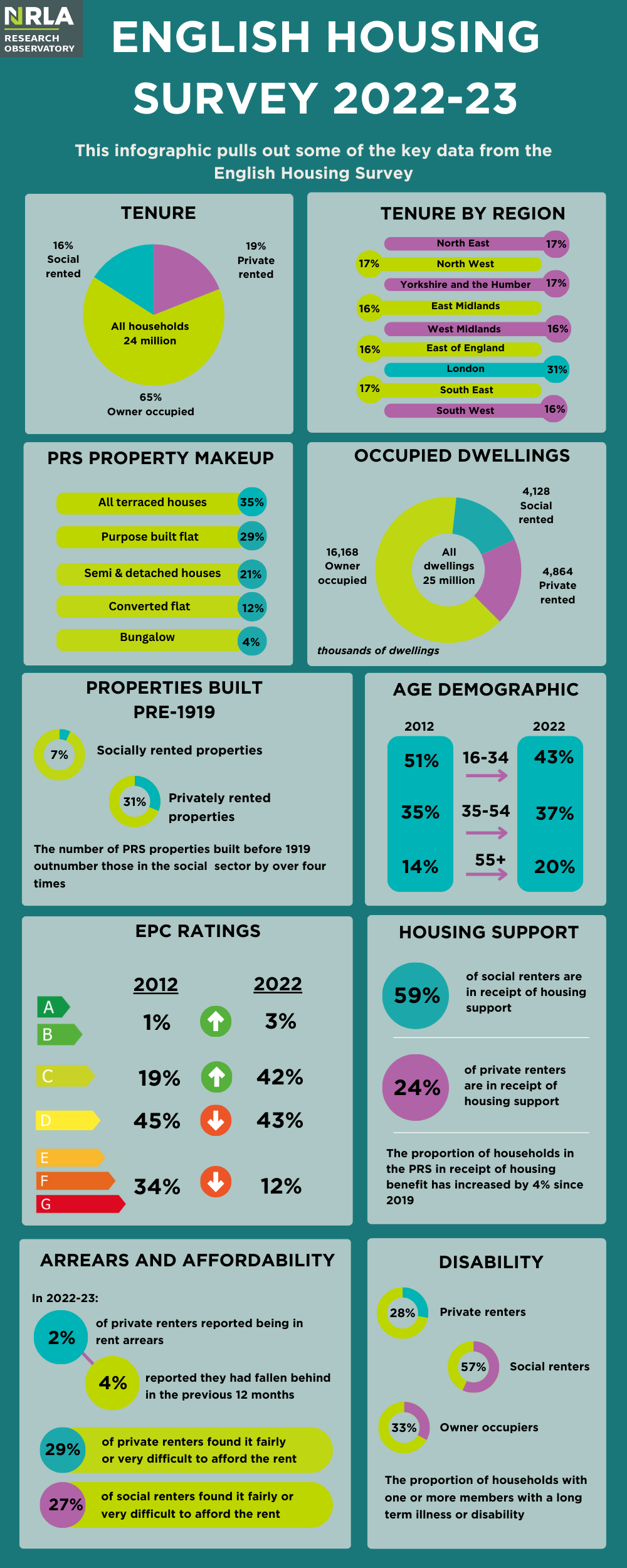

English Housing Survey 2022-23: key points
Introduction
The English Housing Survey (EHS) is a national survey conducted annually, providing data and insights into the condition of housing in England. It covers a wide range of topics including: the quality and safety of housing; energy efficiency; the characteristics of households; housing tenure; and the physical condition of homes.
The survey combines over 11,000 interviews with householders with a similar number of housing inspections to collect detailed information on both housing and households. Note that Covid-19 has had an effect on data collection over the last few surveys, but not this one.
The EHS is an essential tool for government policy-making. It helps to identify housing trends; inform housing policies; and address issues of housing and living conditions. It is one of many sources monitored and quoted regularly by the NRLA.
At present the survey is commissioned by the Department for Levelling Up, Housing and Communities (DLUHC), though departmental ownership changes over time.
Tenure
In England, owner-occupied homes continue to represent the majority of housing, encompassing 65% of all households, or approximately 15.6 million.
- In 2012-13, the private rented sector became larger than the social sector, as measured by the proportion of households across tenures. The private rented sector has since maintained its position as the second largest housing tenure:
- In this most recent survey, 19% (almost 4.6 million) of households in England live in the PRS.
- Meanwhile, social housing comprises 16% of the market, equating to around 4 million households.
Across the regions, this proportion is fairly uniform. But London has a significantly higher proportion of households living in the PRS - 31%.
- The proportion in other regions typically hovers between 16-17%.
Dwellings
- There are approximately 4.9m dwellings in the PRS, of these just over half-a-million were vacant (this figure will include holiday lets).
- This out of a total of 25.2m dwellings.
- A substantial portion (almost one-in-three) of the PRS consist of properties built before 1919.
- This a figure that is four times higher than the social sector (7%).
Older dwellings are among the least energy-efficient. These dwellings often require substantial investment to meet minimum energy efficiency standards.
Energy efficiency
The data shows landlords in the PRS have been investing heavily in energy efficiency measures:
- The proportion of dwellings in the PRS of EPC band A-C has more than doubled.
- The proportion in bands E-G has fallen by almost two-thirds.
The key challenge will be moving properties currently rated 'D' into a more energy efficient band.
Tenants
The profile of tenants in the PRS is slowly but surely becoming more age-mixed, with the proportion of older tenants rising.
Whilst the proportion of tenants in arrears is low, a far higher proportion are finding it difficult to afford the rent.
- Proportionately, far fewer private, compared to social, renters receive housing payment support.
- A much lower proportion of private renters are classed as hosueholds with a long term illness or disability.
Image 1: English Housing Survey: selection of key facts

English Housing Survey 22-23: Key Points

